
Taylor Swift
Since then, Swift began embracing her pop side once again, both with her Taylor’s Version reissues and the 2022 electropop/synthpop heavy, retro 1980s-tinged album, Midnights. These releases collectively paved the way for the resurgence of "Cruel Summer,” which gained further visibility as the sophomore song in her Eras Tour set list, resulting in increased traction on streaming platforms. With fan interest high, the song was finally, and strategically, released as a single in the summer of 2023 (June), subsequently hitting the top 10 of the Billboard Hot 100 in July.
Written by Swift, Jack Antonoff and St. Vincent, “Cruel Summer” embodies the hallmark qualities of a chart-topping pop hit. Vocally, the song adheres to the K.I.S.S. ME principle (keep it simple, singable and memorable), possesses expert vocal production and features a captivating vocal performance from Swift. Adding to the song’s catchiness are its three distinct vocal hooks: a recurring vocoder-infused "yeah” that is featured at three strategic points in the song, the “down below” song title hook and accompanying nonsense vocal in the chorus, and the shouted vocals in the bridge that struck Olivia Rodrigo to such a degree that she incorporated the bridge’s essence in her 2021 hit, “déjà vu,” resulting in additional writing credits.
Structurally, "Cruel Summer" seamlessly blends contemporary pop trends with discernible deviations that underscore its uniqueness. Notable among these differentiating qualities is the presence of two bridges, a departure from the conventional single bridge format, and its significantly shorter-than-average verses, which helped put the song in line with mainstream music’s gravitation towards shorter runtimes.
The expertly crafted, retro-tinged, synth-heavy instrumental arrangement creates a highly engaging musical backdrop that keeps the listener engaged from start to finish and complements the narrative. Furthermore, the song imparts a sense of familiarity to the listener through its incorporation of electropop/synthpop elements and a nostalgic touch of the retro 1980s within its sonic palette. These musical nuances align with micro trends that played a role in shaping notable Hot 100 Top 10 hits both in 2019 and 2023.
"Cruel Summer" by Taylor Swift stands as a testament to the timeless power of exceptional music. Its journey from initial creation to eventual prominence encapsulates the fusion of strategic timing, musical prowess, and an unswerving connection with a devoted audience.
Since its release, “Cruel Summer” has attained global charting success. In the US, it peaked at #1 in the Billboard Hot 100 and topped the Mainstream Top 40 and Adult Top 40 charts. Abroad, it cracked the top 10 on numerous charts, hitting the top spot in Canada, the Philippines and Singapore.
At-A-Glance
Artist: Taylor Swift
Song: "Cruel Summer"
Songwriters: Jack Antonoff, St. Vincent, Taylor Swift
Producers: Jack Antonoff, Taylor Swift
Mastering Engineer: Randy Merrill
Mixer: Serban Ghenea
Record Label: Republic
Primary Genre: Pop
Influences: Retro (1980s), Electropop/Synthpop
Length: 2:55
Form: I-A-PC-B-T-A-PC-B-C-B-C-O
Key: A Major
Tempo: 85 BPM
First Chorus: 0:28 / 16% of the way into the song
Intro Length: 0:05
Electronic vs. Acoustic Instrumentation: Primarily Electronic
Prominent Instruments: Bass (Synth), Drums/Percussion (Primarily Electronic), Synth (Non-Bass)
Primary Lyrical Theme: Love/Relationships
Title Appearances: "Cruel Summer" appears six times in the song
Genres & Influences
Genre & Influence Blend
Key
x: The influence appears minimally within the stanza and/or section

"Cruel Summer" features a combination of pop, electropop/synthpop and retro 1980s influences that are put into effect by the qualities of the vocals, instruments, lyrics, and the overall production.
The song’s main overarching influence, and primary genre, is pop. Notable pop elements include its catchy K.I.S.S. ME (Keep It Simple, Singable and Memorable) melodies and hooks, familiar pop structure, relatable love/relationships-themed subject matter, and polished production, to name a few.
In addition, "Cruel Summer" possesses a strong electropop/synthpop influence, which is put into effect by its heavy use of synths. Some of these synths possess a classic timbre, which along with the mechanical synth bass pattern and use of vocoder provides the song with an underlying early-to-mid retro-1980s vibe.
Blending In & Standing Out in the Hot 100 Top 10
"Cruel Summer’s" expert balance of pop, electropop/synthpop and retro 1980s influences enabled it to both blend in and stand out in the Hot 100 Top 10. While pop in general has been a constant influence in essentially all non-hip hop Hot 100 Top 10 hits over the years, electropop/synthpop and retro 1980s influences are more micro trends that rise and fall in popularity.
Electropop/synthpop, while present in nearly two-thirds of songs in 2018, plummeted to around one-fifth of songs by the end of 2020, before rising again to just over one-third of songs in 2022 and continuing into the first half of 2023. In addition to "Cruel Summer," recent representatives include the #1s "As It Was" (Harry Styles), "Like Crazy" (Jimin), and Taylor Swift’s other recent megahit, "Anti-Hero."
Retro 1980s is even more niche, generally accounting for one-fifth of songs or less over the past decade save for spikes in 2015 (25% of songs) and 2022 (31% of songs). However, save for 2020, where the 1970s rose in popularity, the 1980s has consistently been the most popular decade among retro-tinged hits. Other recent representatives include the aforementioned "Anti-Hero," "As It Was" and "Like Crazy," and the Justin Bieber and The Kid LAROI’s #1 smash, "Stay."
Cruel Summer was also primed for success in 2020, when it was originally slated for release as a single but was put on the backburner due to the emerging Covid-19 epidemic. In the year prior, electropop/synthpop was peaking at just over two-thirds of songs, and retro 1980s, while far less popular at just 13%, was present in notable hits such as "Bad At Love" (Halsey), "Boo’d Up" (Ella Mai), "Never Be The Same" (Camila Cabello) and "Youngblood" (5 Seconds Of Summer).
Influences in the Hot 100 Top 10: 2018 – Q2 2023 (Outside the Hip Hop/Rap Primary Genre)
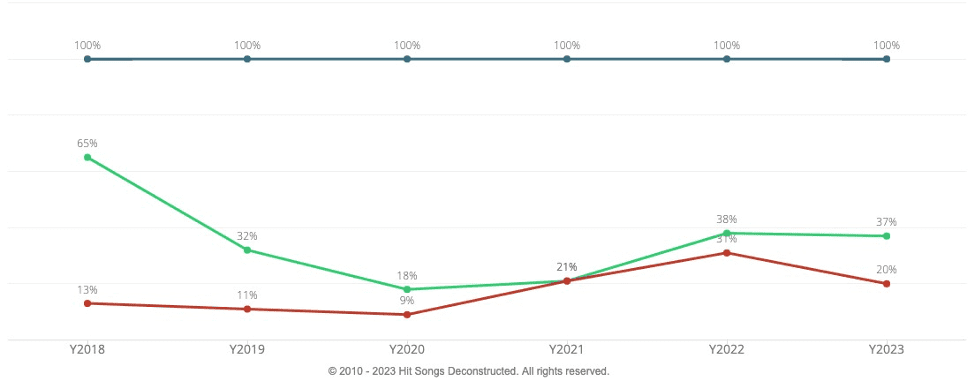
Key
Blue: Pop | Green: Electropop/Synthpop | Red: Retro (1980s)
Instrumental Arrangement
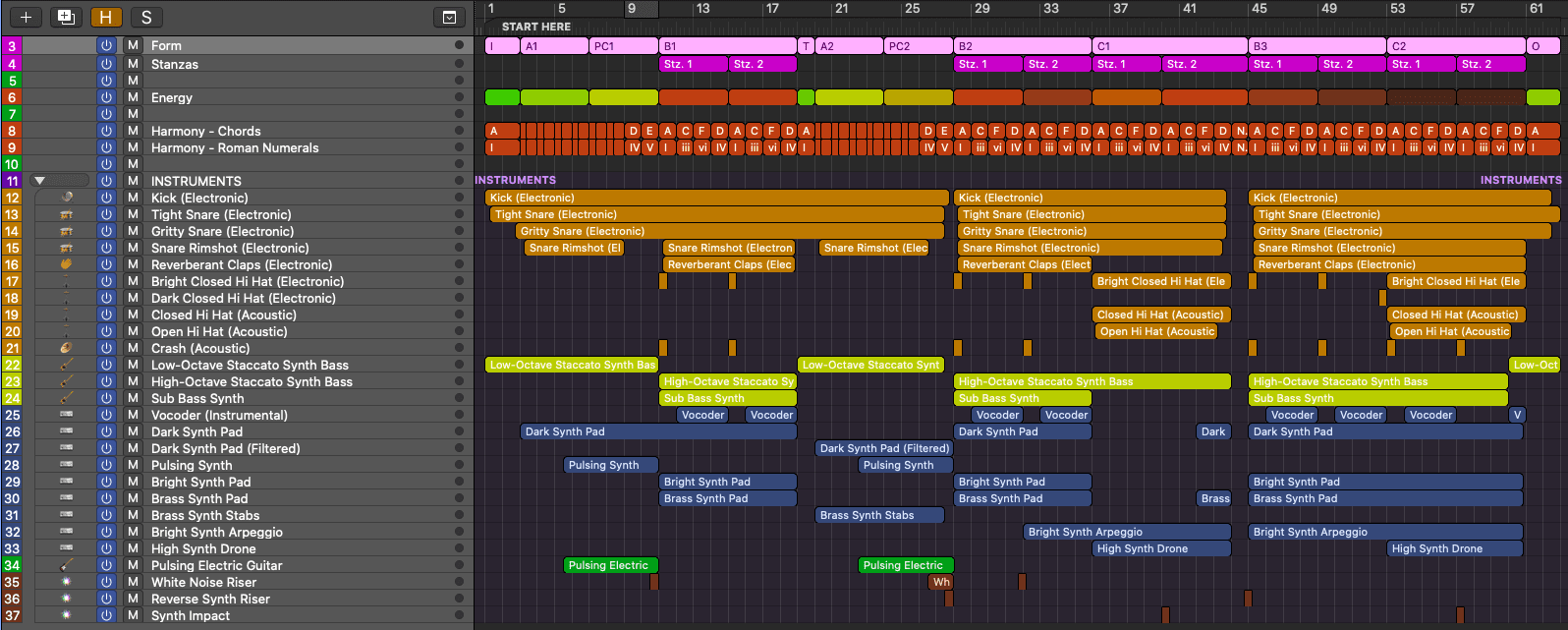
Primary Instruments
Drums/Percussion
Kick (Electronic)
The electronic kick drum is introduced in the intro and drives the groove forward for the duration of the song. It is processed with notable compression to create a punchy timbre that cuts through the mix.
Bright Snare (Electronic)
The bright electronic snare possesses a thin, dry timbre and provides a cohesive backbeat thread throughout the entire song.
Gritty Snare (Electronic)
The gritty electronic snare is layered in with the bright snare in all sections save for the intro and outro. It possesses a bit-crushed distorted timbre and is treated with reverb.
Snare Rimshot (Electronic)
The electronic snare rimshot is initially heard in verse 1 and is present in every subsequent section save for the turnaround. It punctuates the backbeat with a unique, metallic, pitched timbre that stands out in the mix.
Reverberant Claps (Electronic)
The electronic claps are heard in the choruses and bridge 2. Their reverberant, dark timbre contrasts the otherwise brighter and dryer backbeat and contributes to the sections’ dense, climactic arrangements.
Bright Closed Hi Hat (Electronic)
The bright electronic closed hi hat is heard exclusively in the chorus and bridge sections. In each chorus, it provides a subtle roll punctuation to the beginning of each stanza, while in the bridge sections its role is more notable, contributing to the groove throughout. It features a bright, thin timbre, is panned slightly to the right and is featured at a low level in the mix.
Dark Closed Hi Hat (Electronic)
The dark electronic closed hi hat provides a fill between stanzas 1 and 2 of bridge 2 and features a dark, gritty timbre.
Closed Hi Hat (Acoustic)
The acoustic closed hi hat is featured solely in the bridge sections. It provides further rhythmic motion to the section, blending with the closed electronic hi hat.
Open Hi Hat (Acoustic)
The acoustic open hi hat is featured solely in the bridge sections, possessing a gritty timbre identical to its closed counterpart. It punctuates the “and” of beat 1, subtly heightening interest of each section’s rhythm.
Crash (Acoustic)
The acoustic crash is heard punctuating the downbeat of each stanza in the choruses and second bridge at a relatively low level in the mix.
Bass
Low-Octave Staccato Synth Bass
The low-octave staccato synth bass is initially heard in the intro and appears in every subsequent section save for the choruses and bridges. It possesses a saw-wave timbre that is reminiscent of commonly heard Moog synth basses from the 1980s and plays a steady, mechanical sixteenth-note-driven rhythm, also in line with the 1980s.
High-Octave Staccato Synth Bass
The high-octave staccato synth bass is heard in the chorus and bridge sections. It features a filtered saw-wave timbre that effectively balances a strong articulation with an unobtrusive tone, providing an underlying mid-range synth pulse to the arrangement.
Sub Bass Synth
The sub bass synth is featured in the chorus and bridge sections, providing a sustained, sine wave foundation to the low end of the mix.
Synths
Vocoder (Instrumental)
Vocoder serves in more of an instrumental, textural capacity in the choruses and second bridge compared to its vocal hook focus in the intro, turnaround and outro.
Dark Synth Pad
The dark synth pad is initially heard in the first verse, and appears in every subsequent section save for the turnaround, second verse and pre-chorus, and outro. It possesses a filtered, retro-tinged timbre and provides subtle rhythmic and harmonic motion underneath the groove.
Dark Synth Pad (Filtered)
A low-level, heavily-filtered version of the dark synth pad appears in the second verse and pre-chorus.
Pulsing Synth
The pulsing synth is heard in the verses and pre-choruses. It performs a sixteenth-note pattern and possesses a bright timbre that gradually increases in volume leading into first and second choruses.
Bright Synth Pad
The bright synth pad is heard in the choruses and second bridge. It provides further harmonic support with a notably high-end focused, digital, resonant timbre that contrasts from the warm, rich sounds of the brass and dark pads.
Brass Synth Pad
The brass synth pad appears in the chorus and bridge sections. It features a saw wave-timbre reminiscent of a Roland Juno brass patch that further fills out the dense synth-driven arrangement.
Brass Synth Stabs
The brass synth stabs appear solely in the second verse and pre-chorus sections. They are featured prominently in the mix, providing harmonic support while bolstering the retro 1980s influence with a timbre also reminiscent of a Roland Juno.
Bright Synth Arpeggio
The bright synth arpeggio is initially heard in the second stanza of chorus 2 and is featured in every subsequent section save for the outro. It features a bright, percussive timbre and provides further rhythmic motion within the dense arrangement. It is panned across the stereo field and is at a low level in the mix, becoming most audible when reaching higher-register notes in sparser sections.
High Synth Drone
The high synth drone pad provides a sustained, high-pitched note to the bridges. It features a bright timbre that helps balance out the many mid-range synth layers and is relatively low in the mix.
Guitar
Pulsing Electric Guitar
The sole guitar in the song is heard in the verses and pre-choruses. It features a gritty, mid-range tone that gradually increases in volume over the course of its performance.
Effects
White Noise Riser
The white noise riser possesses a bright, noise-based timbre, functioning in an engagement-heightening, transitional role at the end of the pre-choruses and between stanzas 1 and 2 of the second chorus.
Reverse Synth Riser
The reverse synth riser provides an engaging transition between the second pre-chorus and chorus sections. It possesses a reversed saw-wave synth timbre that creates a swelling effect to maximize the chorus’s arrival.
Synth Impact
The synth impact occurs solely in between stanzas 1 and 2 of the bridges, punctuating the second stanza with a downlifting, pitched synth stab.
Instrumental Arrangement: Section By Section
Intro (0:00 – 0:05)
Chord Progression: A (A major: I)
“Cruel Summer’s” intro features the sparsest arrangement in the song, consisting of kick, snare, and synth bass. Note that the sparse intro technique has consistently been one of the two most common techniques used in Hot 100 Top 10 hits over the past decade (along with the backing music technique, which the song also possesses), as it provides a springboard to establish key aspects of the song while providing room for growth in subsequent sections.
Sonically, all the elements have a distinct electronic quality, which along with their timbres and patterns creates an engaging, retro-1980s inspired tapestry that instantly engages the listener.
On the lower end of the frequency spectrum is the kick drum, which plays a vibrant pattern and is processed with a prominent short tail reverb to give it a spacious, big sound. Contrasting it is the tight snare, which covers the mid/high frequency range with its notably brighter, tighter timbre and steady backbeat pulse.
Rounding out the instrumental arrangement is the low-octave staccato synth bass. It establishes the song’s key and provides the mix with a 1980s-inspired texture through its saw-wave timbre, reminiscent of a Moog synthesizer and a mechanical sixteenth-note pattern that possesses a Kraftwork and Devo-esque quality. Also note the brief leap that occurs on the “and” of beats 2 and 4, which subtly heightens interest against its otherwise stagnant pattern.
In addition to the above, the consistency of the arrangement serves as an effective backdrop for the vocoder-processed vocal hook to shine. It serves in both vocal and instrumental capacities, contributing to the section’s texture, rhythm, and catchiness.
At the end of the section, a new snare is heard on the last beat, possessing a grittier timbre that sustains longer than the tight snare. Punctuating the mix, it subtly serves to usher in the ensuing verse without disrupting the groove.
Intro Arrangement: At-A-Glance
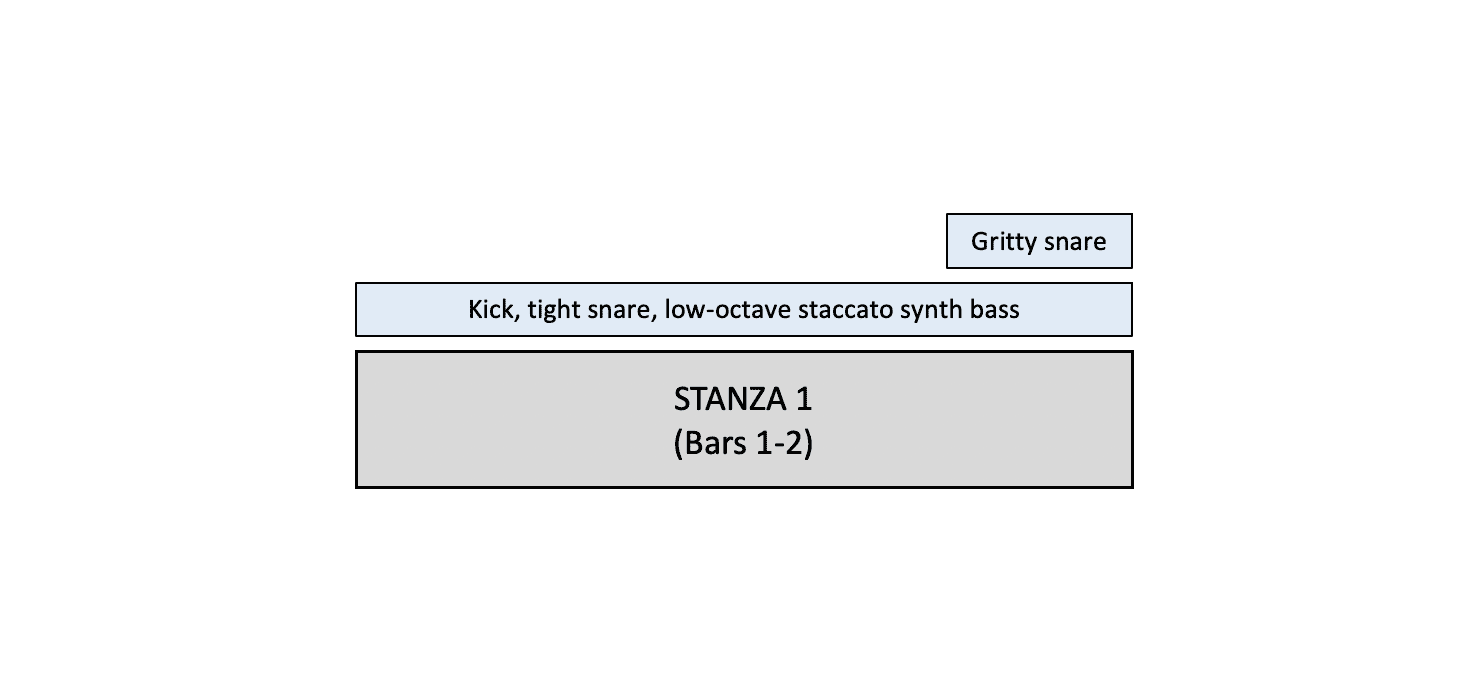
Verse 1 (0:05 – 0:17)
Chord Progression: D – E – C#m – F#m (A major: IV-V-iii-vi)
With the intro arrangement remaining in effect to provide cross-section continuity and allow the listener’s full attention to be on Swift’s first installment of the narrative without distraction, the following instrumental elements are added to the mix to heighten cross-section interest:
- The gritty snare and new snare rimshot are added to the backbeat. Both provide the verse with an interest-heightening textural development that also punctuates the backbeat against Swift’s lead vocal and the vocoder-processed background vocals.
- A dark synth pad plays a legato pattern over the continuation of the low-octave staccato synth bass from the intro. Possessing a filtered, retro 1980s-tinged timbre, its addition serves a few key purposes, including providing additional texture, color and density to the mix, adding an additional harmonic layer and motion, and providing a subtle dark and foreboding vibe that creates prosody with the song title, “Cruel Summer.”
- In bar 3, a pulsing synth and electric guitar enter the mix, playing sixteenth-note patterns at a low level. In addition to contributing to the section’s sonic tapestry, they serve to subtly heighten interest midway through the verse and begin to increase tension in anticipation for the impending chorus by way of the ensuing pre-chorus.
Verse 1 Arrangement: At-A-Glance
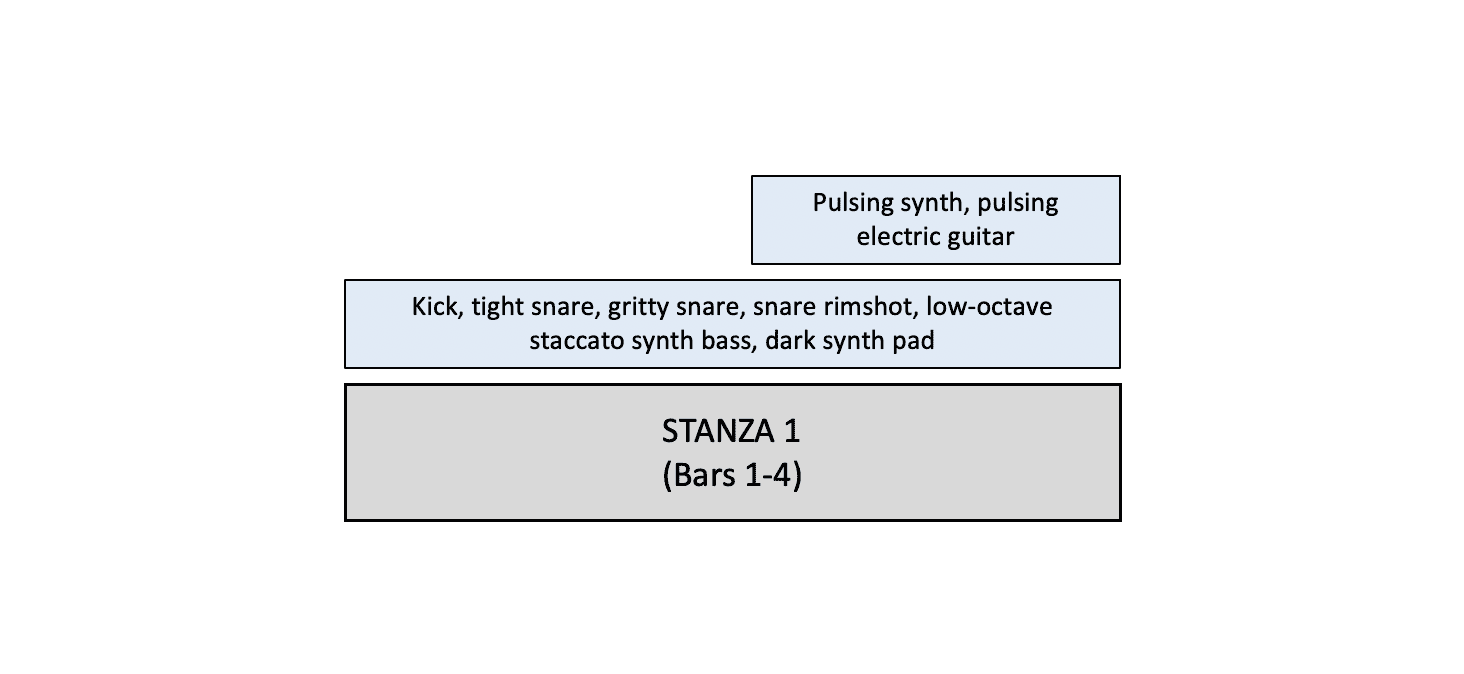
Pre-Chorus 1 (0:17 – 0:28)
Chord Progression: D – E – C#m – F#m – D – E (A major: IV-V-iii-vi-IV-V)
The verse arrangement seamlessly carries over into the pre-chorus and features little development throughout the section. This puts the spotlight on the engaging vocals and lyrics which, along with the continuation of the pulsing synth and guitar, continues to heighten tension and anticipation for the impending chorus.
There are a few subtle developments, however, in the last two bars that serve to further heighten anticipation for the chorus and bolster its impact when it arrives. This culminates into the Hit Songs Deconstructed S.I.A. (section impact accentuator) technique in the last beat of the section, unfolding as follows:
- The harmonic progression simplifies, sustaining on the V chord at the end of the section, which further heightens tension leading into the chorus.
- The rimshot is removed from the mix. This results in a slightly smaller, more contained sound on the backbeat that allows the bigger sounding chorus to hit with greater perceived impact.
- The pulsing synth and guitar increase in volume, which along with the white noise riser, takes tension and anticipation to a climax, resulting in the S.I.A. in the last beat.
Pre-Chorus 1 Arrangement: At-A-Glance
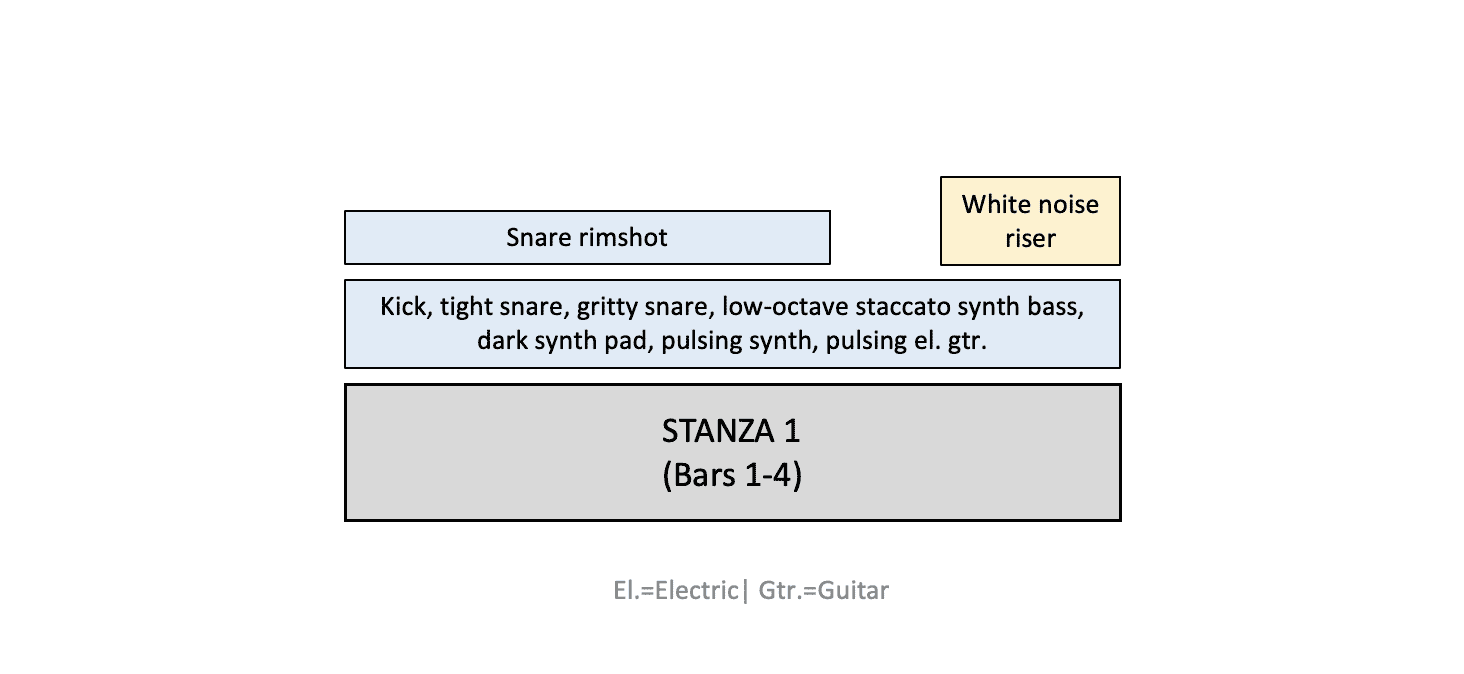
Chorus 1 (0:28 – 0:51)
Chord Progression: A – C#m – F#m – D (A major: I-iii-vi-IV)
Following the tension and anticipation-heightening pre-chorus, the chorus hits with a notably denser, “wall of sound” synth-driven production, punctuated by an acoustic-timbred crash and closed hat roll on beat 1.
With the core drum groove and dark synth pad from the pre-chorus providing cross-section cohesion and continuity, the following elements are added to, or changed up, in the chorus:
- The snare rimshot is added back in along with the new reverberant claps. Together, they further punctuate the backbeat and contribute to the chorus’ deeper, bigger, and more powerful sound.
- Two new, similarly functioning synth pads are introduced that contribute to density, provide harmonic support and further fill out the frequency spectrum: A 1980s-sounding brass synth pad, which features a saw wave timbre reminiscent of a Roland Juno brass patch, and a bright synth pad that features a digital, resonant timbre that contrasts from the warmer, richer sounds of the other pads in the mix.
- The vocoder is added back in for the first time since the intro. However, here it is notably lower in the mix and melding with the other synths to contribute unique texture and color the sonic landscape as opposed to delivering a standout vocal hook.
- A high-octave staccato synth bass replaces its low-octave counterpart heard across the first three sections of the song. While it’s relatively low in the mix, its addition contributes mid-range texture along with subtle forward motion.
Like the verse, and most of the pre-chorus before it, the chorus arrangement remains essentially static from start to finish, save for the familiar crash and hi hat roll that punctuates the arrival of stanza 2. Again, this allows the listener’s full focus to be on the catchy, evocative, hook-based vocals while elevating the section’s emotional connection with the listener.
Chorus 1 Arrangement: At-A-Glance
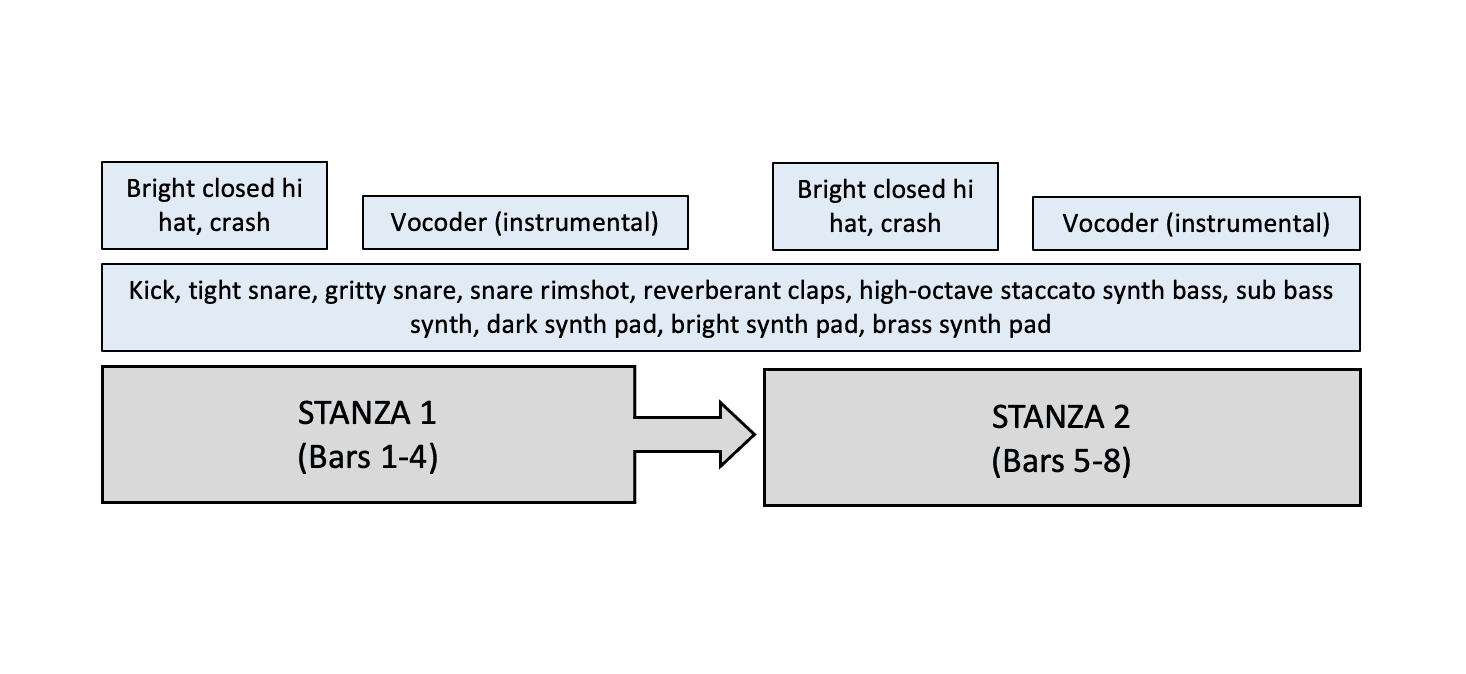
Turnaround (0:51 – 0:53)
Chord Progression: A (A major: I)
Following the dense, high-energy chorus, the brief one-bar turnaround breaks down to the sparser, lower energy intro arrangement, minus the gritty snare. This, along with the notable reverb processing and mid-range focus, creates engaging contrast that both spotlights the return of the “yeah” vocoder hook and provides room for the song to build once again in the ensuing sections.
Turnaround Arrangement: At-A-Glance

Verse 2 (0:53 – 1:05)
Chord Progression: D – E – C#m – F#m (A major: IV-V-iii-vi)
Following the brief, transitional turnaround, verse 2 engages the listener at a heightened level through a return to the core verse 1 arrangement along with new and changed up elements. Together, they serve to heighten both familiarity and interest as the song progresses.
Notable verse 2 developments:
- Brass-timbred synth stabs are uniquely added to the mix, providing engaging like-section contrast. Featured prominently in the mix, they further heighten the song’s retro 1980s vibe and create a subtly more positive mood compared to the darker-timbered verse 1.
- The dark synth pad, which was featured prominently in verse 1, is now filtered and positioned further back in the mix. This effectively makes way for the brass synth stabs and the comparative shift in mood between verses.
In the last two bars of the section, the pulsing synth and guitar return, once again heightening tension and anticipation as the verse seamlessly transitions into the pre-chorus.
Verse 2 Arrangement: At-A-Glance
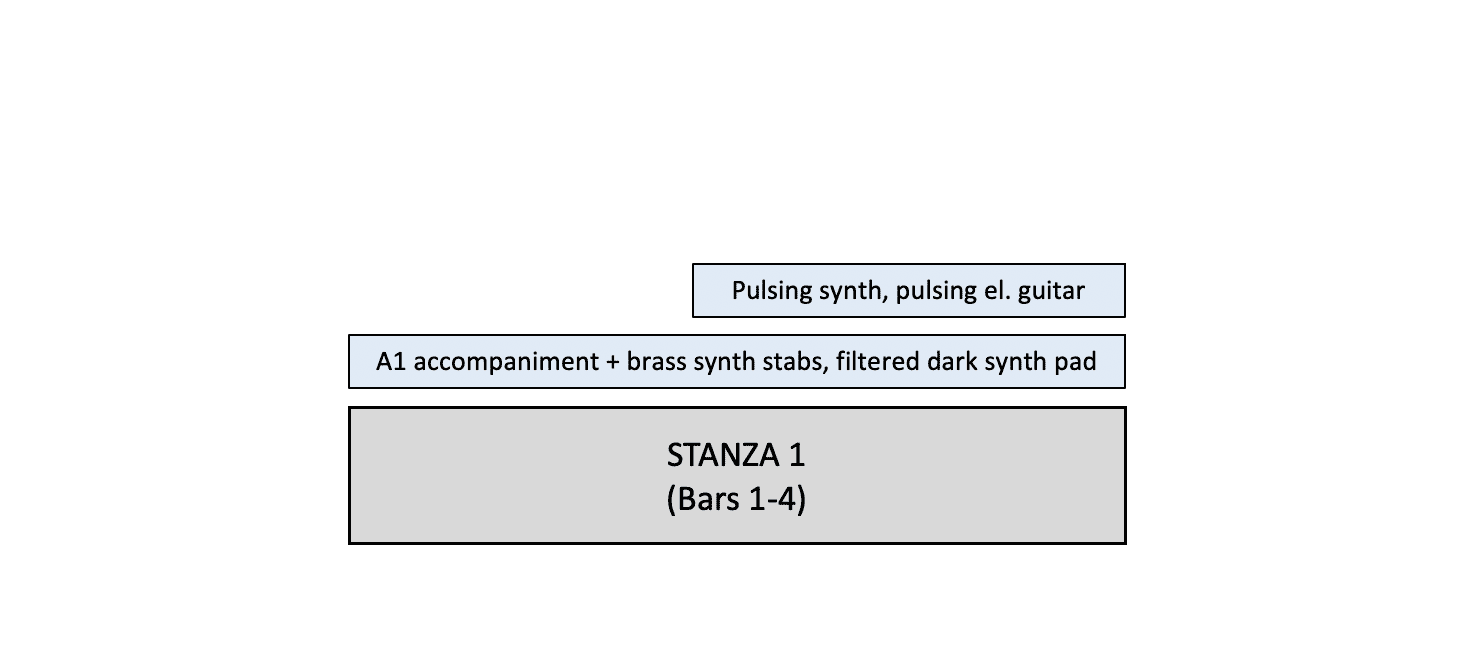
Pre-Chorus 2 (1:05 – 1:16)
Chord Progression: D – E – C#m – F#m – D – E (A major: IV-V-iii-vi-IV-V)
The verse 2 – pre-chorus 2 relationship is highly similar as the first time around, which creates structural familiarity in the scope of the song. Pre-chorus 2 initially maintains the verse 2 arrangement, creating cross-section cohesion, followed by the tension-heightening pulsing synth and guitar increasing in volume and the S.I.A. (section impact accentuator) technique being employed in the last two beats.
Here, the arrangement unfolds into the S.I.A. as follows:
- The rimshot is removed, creating a timbral shift on the backbeat.
- The remaining backbeat elements, brass synth stabs and low-octave staccato synth bass are then removed for the last two beats, further stripping back the arrangement.
- Lastly, the kick is omitted from the final beat of the section, leaving the sustained dark synth, pulsing synth and guitar, and white noise and reverse synth risers to usher in the chorus in an engaging manner.
Pre-Chorus 2 Arrangement: At-A-Glance
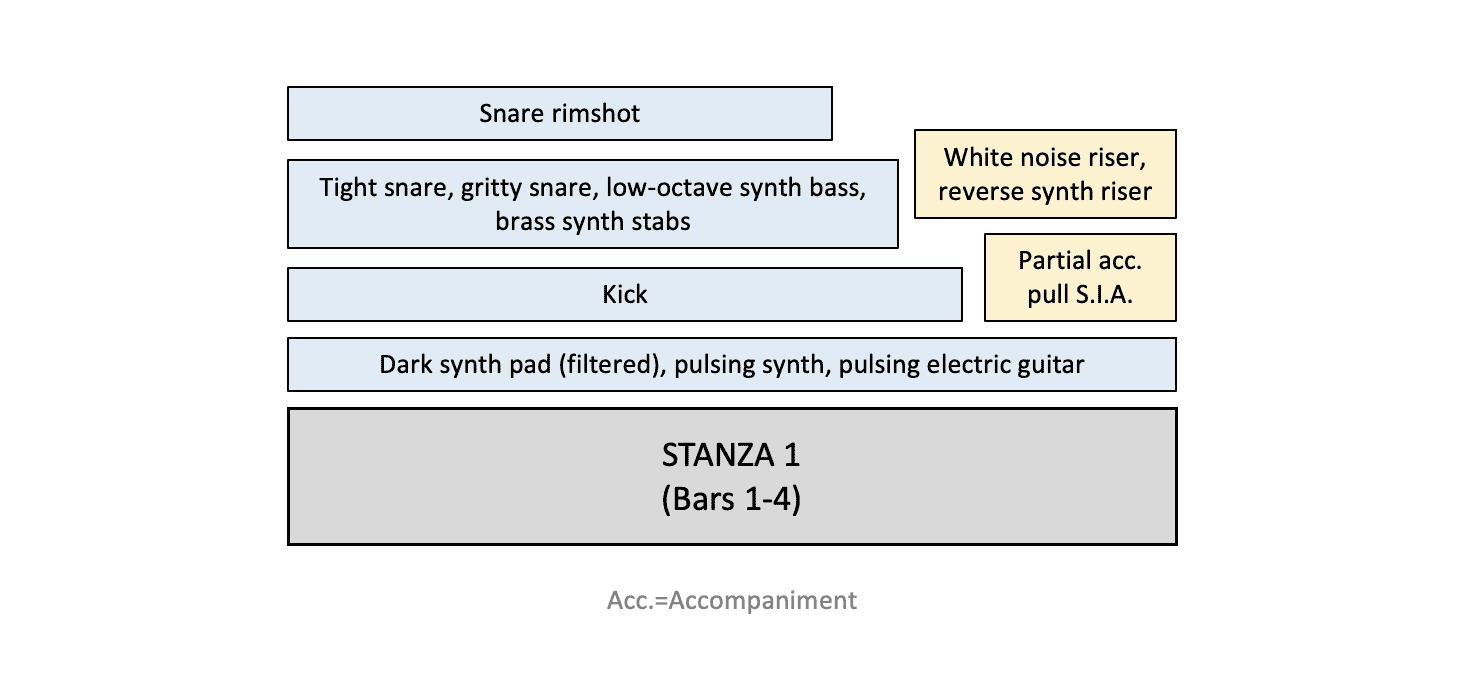
Chorus 2 (1:16 – 1:39)
Chord Progression: A – C#m – F#m – D (A major: I-iii-vi-IV)
The chorus 2 arrangement is highly similar to its chorus 1 counterpart, which bolsters the familiarity factor of the song’s primary “hook center.” However, in addition to the added vocal layers, there are two instrumental differences in the second stanza that, while subtle, contribute to density, texture, color and prevent instrumental redundancy:
- A low-level bright synth arpeggio is added to the mix. In addition to the above, it also subtly contributes to the section’s rhythmic motion.
- The synth pads swell to a more prominent level compared to the first time around. This also serves to subtly heighten the section’s excitement factor as it comes to a close.
Chorus 2 Arrangement: At-A-Glance
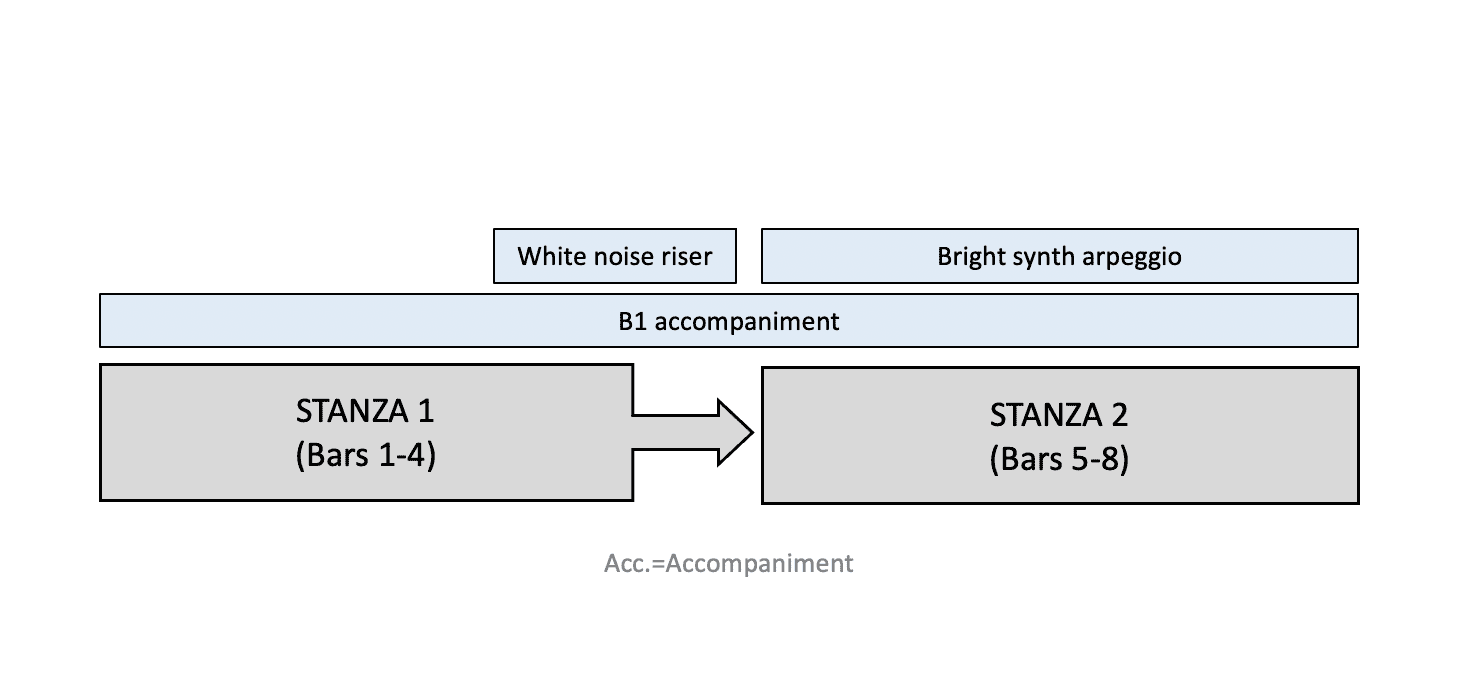
Bridge 1 (1:39 – 2:04)
Chord Progression: A – C#m7 – F#m7 – D – A – C#m7 – F#m7 – D – N.C. (A major: I-iii7-vi7-IV-I-iii7-vi7-IV-N.C.)
Bridge 1, which serves as the song’s main “D” (departure) section, provides a notable, engaging shift in the instrumental arrangement compared to the other song sections, along with changeups in vocals and lyrics.
With the core kick and snare groove from the chorus providing cross-section continuity, the mix shifts to a highly rhythmic and notably brighter (higher frequency) instrumental arrangement compared to the preceding sections that works in tandem with Swift’s more excited vocals to bolster the impact of the lyrics.
- The sub bass and synth pads are removed from the mix, leaving the high-octave staccato synth bass and bright arpeggio synth driving the section forward along with the drums.
- A high synth drone is introduced, sustaining a high note that further contributes to the section’s higher frequency focus.
- Bright closed electronic hi hat, closed acoustic hi hat, and open hi hat shift to a steady, thirty-second-note rhythm, driving the song forward with a heightened degree of momentum
In the last three bars of the section, the dark synth pad and brass synth pads are reintroduced. Together, they fill out the mid to low-end of the mix while their gradually increasing volume and cutoff frequency serve to heighten tension, anticipation and engagement leading into the final chorus of the song.
However, instead of leading directly into the chorus, the buildup is subverted by what Hit Songs Deconstructed calls the “Last Chorus Super S.I.A.” technique. Here, an extra bar is tacked onto the end of the bridge, where all the elements are removed from the mix save for Swift’s lead vocal until the last beat when a reverse synth riser ushers in the ensuing chorus. This jarring, unexpected moment notably heightens the listener’s engagement and bolsters the impact of the chorus in the process.
Bridge 1 Arrangement: At-A-Glance
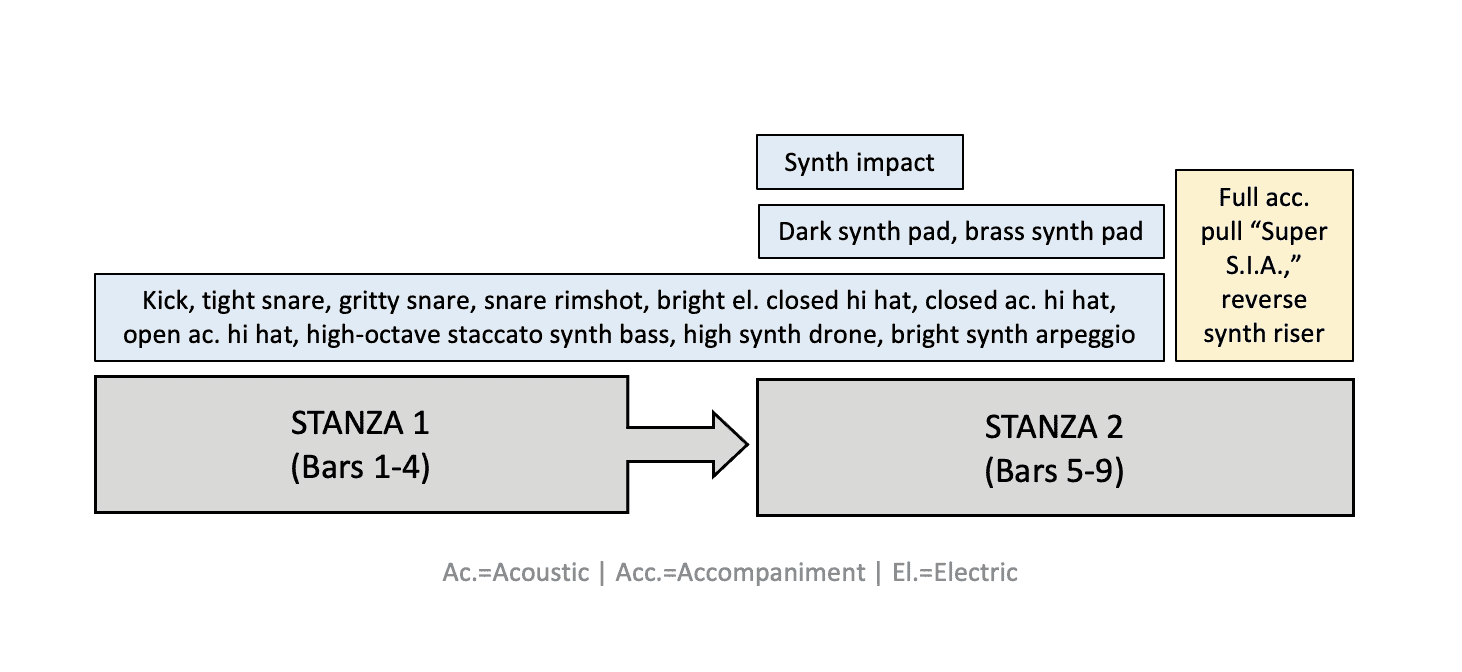
Chorus 3 (2:04 – 2:27)
Chord Progression: A – C#m – F#m – D (A major: I-iii-vi-IV)
Following the pronounced, engagement-heightening “Super S.I.A.” technique at the end of the bridge, the third and final chorus hits hard with a return to the familiar, dense arrangement that defines the second stanza of chorus 2. However, to prevent “cookie-cutter” redundancy, the synth layers feature more active rhythmic motion and have brighter timbres, which results in a subtly more excited and energetic vibe. At the end of the section, a dark closed hi hat enters to usher in the second bridge.
Chorus 3 Arrangement: At-A-Glance
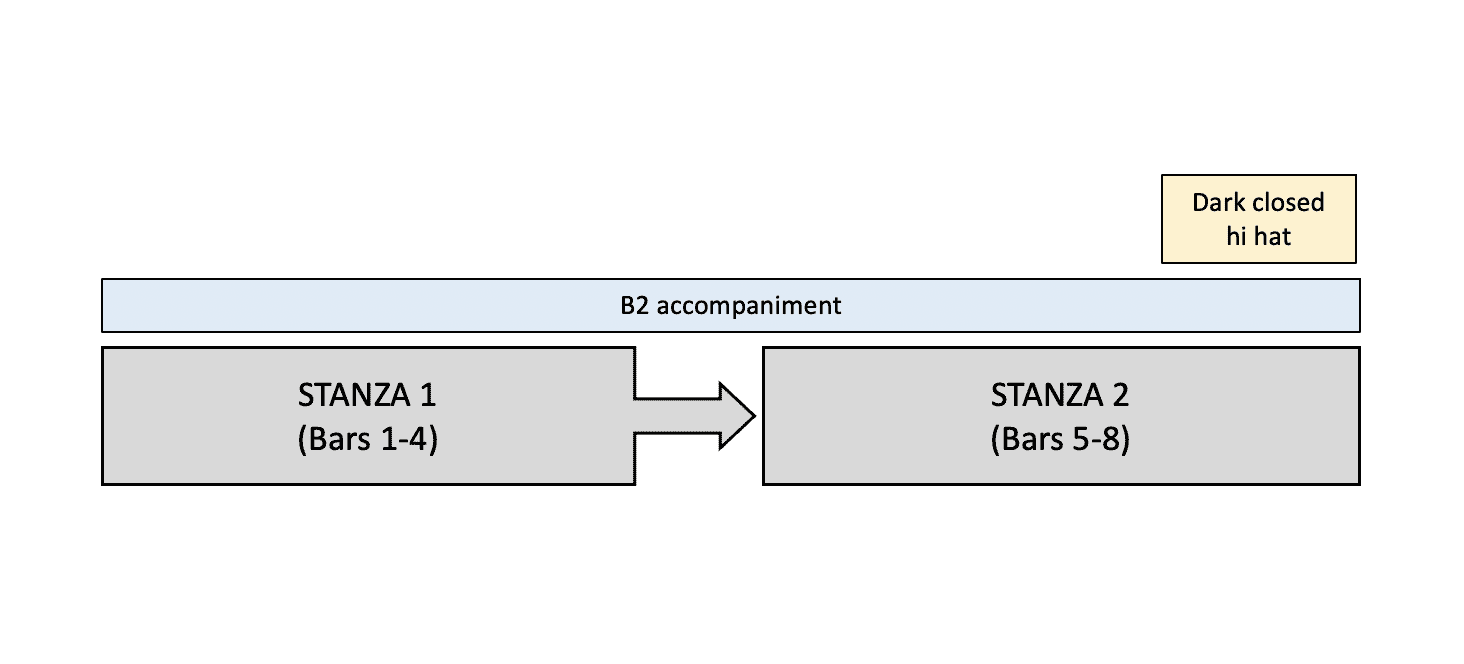
Bridge 2 (2:27 – 2:49)
Chord Progression: A – C#m7 – F#m7 – D (A major: I-iii7-vi7-IV)
The atypical second bridge uniquely fuses the bridge 1 and chorus 3 instrumental arrangements to take the song’s intensity to a grand peak. With the chorus 3 instrumental arrangement remaining in effect to provide cross-section continuity, the high frequency hi hats and high synth drone from bridge 1 are added in, which together, along with a reprise of Swift’s excited bridge 1 vocals, takes the song to an emotional climax.
At the end of the section, the last bar omits the sub bass and high-octave bass from the mix, allowing the low-octave bass to set the stage for the ensuing outro.
Bridge 2 Arrangement: At-A-Glance
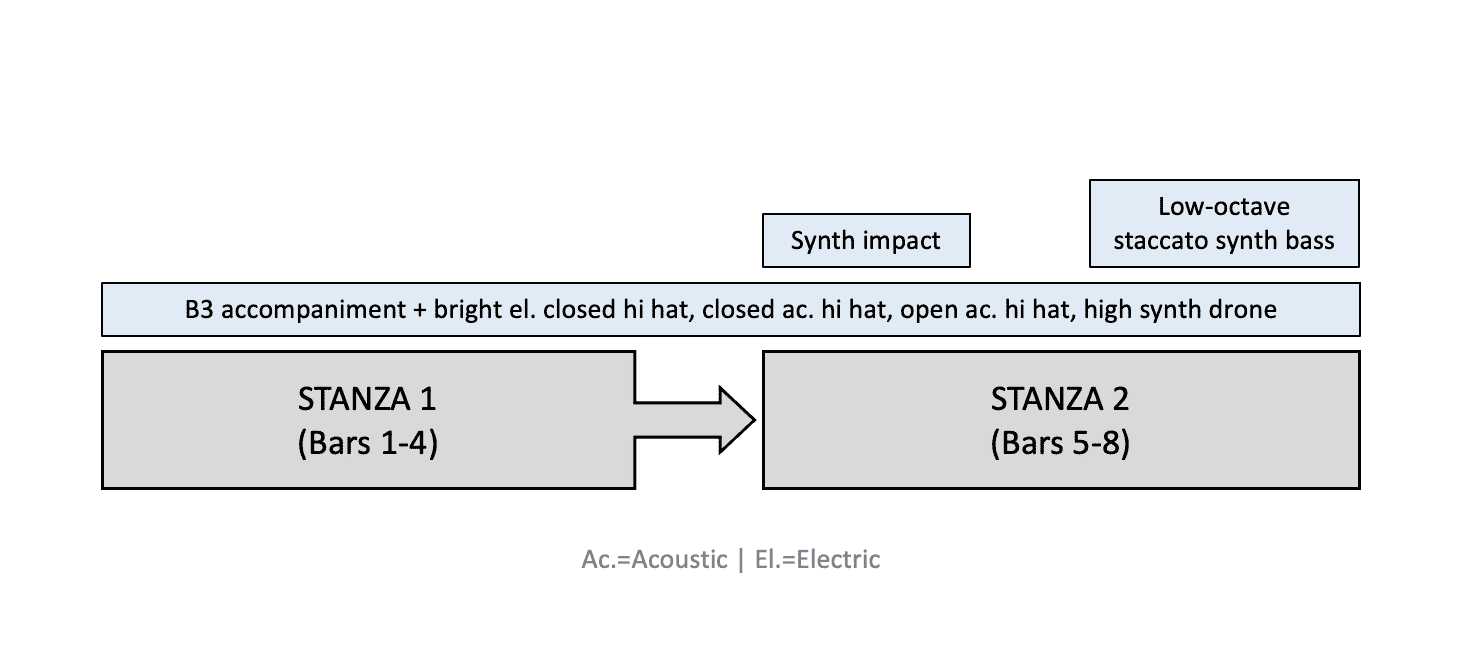
Outro (2:49 – 2:55)
Chord Progression: A (A major: I)
Following the climactic second bridge, the outro notably breaks down to just kick, tight snare, gritty snare and low-octave synth bass. This bookends the song on a familiar note while showcasing the vocoder vocal hook as the song winds down. Note, however, that compared to the similarly arranged intro and turnaround sections, the low-octave synth bass opens the cutoff filter in the last bar. This creates a sense that the outro is building toward something, but instead ends abruptly with a “pulling of the plug” quality at the tail end.
Outro Arrangement: At-A-Glance
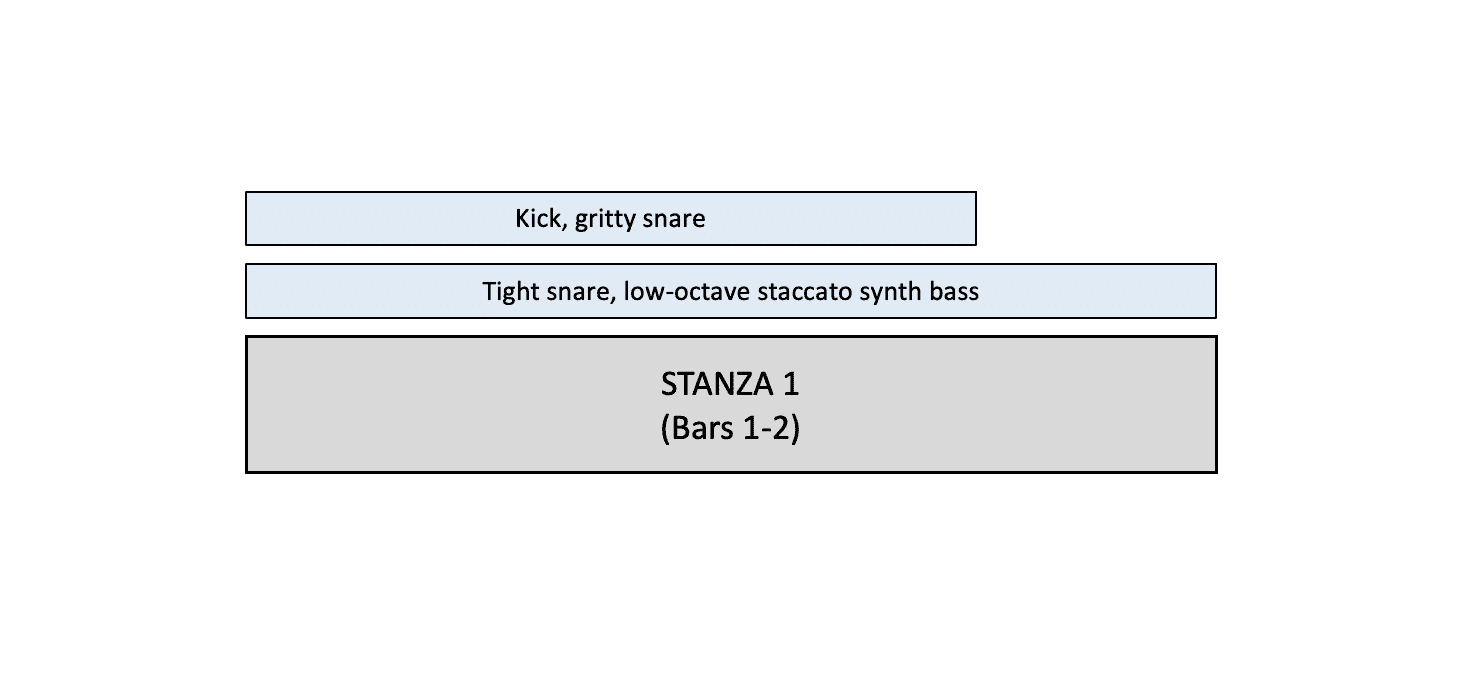
Companion
Logic Project
This file includes the correct meter, tempo and song arrangement displayed as empty MIDI regions for each instrument. Load your copy of the song to see when each instrument enters and leaves the mix, how the arrangement of like and cross-sections compare, how energy and dynamics are working from an arrangement point of view, and more.
Skip To: